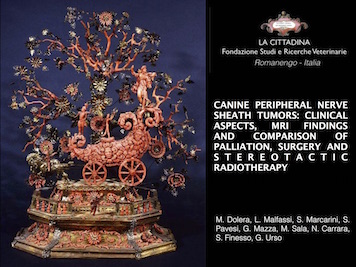CANINE PERIPHERAL NERVE SHEAT TUMORS: CLINICAL ASPECT, MRI FINDINGS AND COMPARISION OF PALLIATION SURGERY AND STEREOTACTIC RADIOTHERAPY
No updates for canine peripheral nerve sheaths tumor (PNST) appeared in recent literature. The aim of this study was to evaluate the correlation between clinical aspects and MRI findings of tumors involving a major peripheral nerve, plexus or root and to determine the survival time in dogs treated with palliation, surgery or stereotactic radiotherapy (SRT). Records of dogs with PNST evaluated from 2000 to 2014 were reviewed to determine signalment, duration of clinical signs, neurological examination, MRI features, treatment option (palliation, surgery, stereotactic hypo fractionated radiotherapy). Time to first event, survival times and statistical differences across categories were calculated by the Kaplan-Meier product limit method and log-rank test. Forty-seven dogs (median age 9 years, male:female ratio 1.76) were included, with Labrador retriever over represented (17%). Roots lesions were the most frequent (46.8%), with C5-T1, V nerve and left side more involved (25.5%, 19.1% and 61.7%). Presenting sings were lameness, paresis and pain. Mean duration of clinical signs was 90 days. MRI findings comprises increased diameter, hyper intense and contrast enhancing nerve roots (57.1%), plexus or peripheral nerve (42.9%), focal hypomiotropy and muscle hyper intensity (73%). The time to first event was 30 days after surgery and 240 days after SRT. Overall mean survival was 97, 144 and 371 days with palliation, surgery and SRT. A predilection for Labrador retriever is observed. Comparing our results with published data, SRT seem to promise better results than palliation or surgery and warrant further evaluation.
